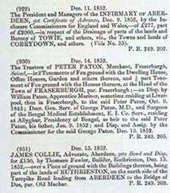
|
Historical records relating to property in Scotland are held by a variety of different archives and by other public and private institutions in Scotland. For more information about property and frequently asked questions about property records, see below. For an essay by David Sellar, Faculty of Law, Edinburgh University, on the feudal origins of Scottish property law, see 'Farewell to Feudalism' by clicking here. |
||||||
|
|
||||||
| Types
of property Legally speaking, property in Scotland is either ‘heritable’ or ‘moveable’. In origin this was a distinction between landed property and moveable goods. Thus land, houses and minerals in the ground were heritable; furniture, farm stock and minerals which had been mined were moveable. But property could become heritable 'by connection' with heritable property. Thus liferents, feu duties and casualties of superiority, leases and teinds were all heritable. Property could also become heritable 'by destination', that is, by being so specified by the owner. Moveable property includes money, furniture, personal possessions, clothing, and other valuables. Heritable property
When ownership of heritable property changes, through sale or inheritance for example, the property is conveyed. Usually a lawyer draws up a title deed, and these have often survived among the records of the lawyer’s office (and may later have been deposited in archives), or among the personal papers of the family or individual who owned the property (sometimes these too are deposited in archives). Where a family owned an estate, the surviving records of property management are referred to as estate papers, and many collections of estate papers are either in archive offices or still held privately by the families that created them. The survival of individual title deeds
is haphazard. However, the majority of conveyances in Scotland from
1617 until the late 20th century were sent by lawyers to be registered
in centrally held registers known collectively as the register of
sasines. For more details about the early register of sasines (before
1781) see the fact sheet on sasines on the
National Archives of Scotland website.
For details of sasines after 1781 go to the Knowledge Base entry
on Sasine Abridgements. Moveable property
For further information about wills and testaments and sederunt books, see the Knowledge Base entries on Wills and Testaments and Trust Sederunt Books. Further information about household accounts mayl be added to this website in due course. Contributors: |
1. How is the word 'sasines' pronounced and what does it mean? 2. What do the abbreviations in Sasine Abridgements stand for? 3. What is, or was, a liferent? Image 1 For an essay by David Sellar, Faculty of Law, Edinburgh University, on the feudal origins of Scottish property law, see 'Farewell to Feudalism' by clicking here.
|
|||||
| <<Back |
![]()
